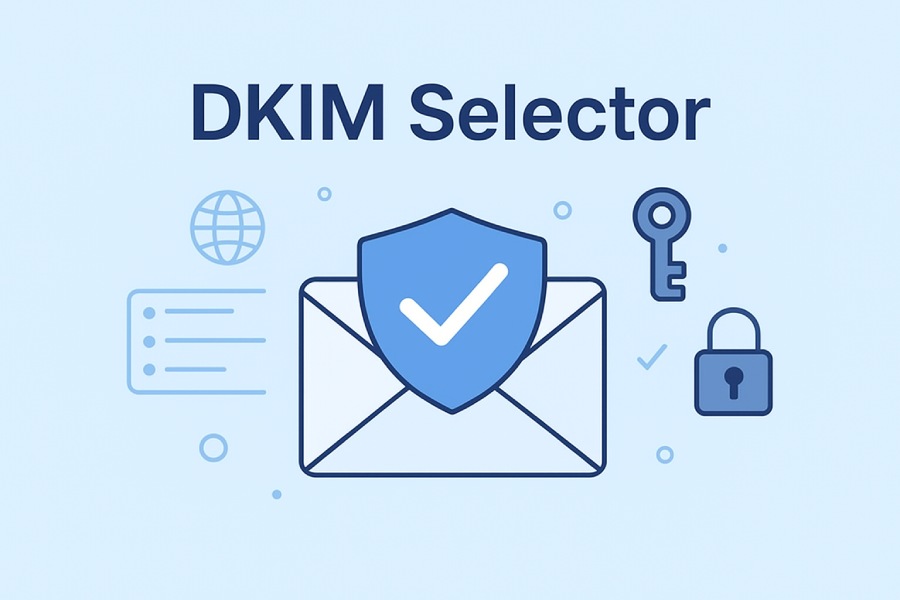DomainKeys Identified Mail (DKIM) is a critical component of modern email security standards and plays a vital role in email authentication frameworks alongside Sender Policy Framework (SPF) and Domain-based Message Authentication, Reporting & Conformance (DMARC).
Defined by RFC 6376, DKIM enables mail servers and mail transfer agents to verify that inbound email messages are cryptographically authorized by the sender’s domain and have not been altered during transit. This is achieved through email signing, where a sender’s private key creates a cryptographic signature appended to the email header. Recipients use the corresponding public key, published as a DNS TXT record in the domain’s DNS infrastructure, to validate the signature.
This message authentication mechanism helps prevent email spoofing and email fraud, thereby safeguarding sender reputation and improving email deliverability. Major email providers such as Google (Gmail), Microsoft (Outlook), Yahoo, and email platform services like Amazon SES, SendGrid, Mailchimp, and Postmark rely heavily on DKIM for email trust and compliance with email security policies. Through DKIM, organizations fortify their mail flow by ensuring message integrity and verifiable domain verification while reducing the likelihood of authentication failure and email spam filtering.
What is a DKIM Selector? Definition and Purpose
At the heart of the DKIM framework is the DKIM selector. This selector tag functions as an identifier within the email header that specifies which public key should be retrieved from the DNS records for signature validation. In essence, the DKIM selector allows email receivers to pinpoint the correct DNS TXT record containing the public key necessary to verify the cryptographic signature applied by the sending mail server.
The selector is embedded in the “DKIM-Signature” header field of an email, which is part of the email headers analysis conducted during the authentication process. It uniquely identifies a key pair associated with a domain’s public key infrastructure (PKI), enabling multiple keys to coexist simultaneously in the DNS infrastructure for the same domain — a practice essential in large-scale email environments and during key rotation events.
Without the DKIM selector, DNS record configuration would be ambiguous, significantly increasing the risk of selector mismatch, which commonly results in signature validation failures that degrade sender reputation and email deliverability.
How DKIM Selectors Work in Email Authentication
When an outbound email is sent via SMTP, the sending mail transfer agent applies a DKIM signature created with the domain’s private key. This signature is included in the email header alongside the selector tag. Upon receiving the email, the recipient’s mail server or email gateway retrieves the appropriate public key via a DNS TXT record query based on the selector and domain indicated in the DKIM header.
The public key retrieved from DNS is then used to perform signature validation, confirming whether the signature matches the email content and headers. This step ensures message integrity and authenticates the sender, thereby upholding the sender policy and deterring email spoofing attempts.
The selector-based system also mitigates risks arising from DNS configuration errors. If the selector tag in the email header points to a non-existent or incorrect DNS TXT record, the authentication process fails, leading to an authentication failure that negatively affects email compliance, sender reputation, and potentially places the email into spam folders or blocks it outright.
The Role of DKIM Selectors in Managing Multiple Keys
Organizations utilizing DKIM often manage several key pairs concurrently to support different business units, third-party email services, or staggered key rotation schedules. DKIM selectors provide the necessary mechanism to distinguish among these keys for seamless email signing and verification.
For example, a company using both Microsoft Exchange Online and Amazon SES might deploy different DKIM selectors for each email service, each linked to unique public keys in the DNS infrastructure. Vendors like SparkPost, Zoho Mail, ProtonMail, and Fastmail also implement selectors as a core component of their DKIM deployment, enabling service-specific key management while maintaining overall domain-level email security.
Key rotation, a best practice recommended by email security standards and email compliance frameworks, often involves publishing new public keys under new selectors before retiring old keys. This method minimizes disruption to mail flow and enhances email fraud prevention. Notably, email security vendors such as Cisco, Proofpoint, Barracuda Networks, Mimecast, Valimail, Agari, and Dmarcian provide tools to automate and monitor DKIM selector and key management, reducing the possibilities of selector mismatch and DNS propagation delays impacting email deliverability.
How to Choose and Configure DKIM Selectors Properly
Selecting and configuring DKIM selectors correctly is paramount to ensuring robust email authentication and maintaining a strong sender reputation. Best practices across major email platforms and services like Gmail, Outlook, Mailchimp, and Postmark emphasize the following:
- Selector Naming Conventions: Use easy-to-recognize alphanumeric names that indicate the service or rotation timeline, such as `google`, `mailchimp2024`, or `ses1`. This clarity aids DNS management and troubleshooting.
- DNS TXT Record Configuration: Publish the public key associated with the private key under the fully qualified domain name (FQDN) format `._domainkey.`. For example, if your selector is `selector1` and your domain is `example.com`, the DNS record would be `selector1._domainkey.example.com`. Ensure that the TXT record strictly follows the DKIM DNS syntax requirements to prevent DNS configuration errors.
- Coordinated Key Rotation: When rotating keys, add the new key and selector to DNS before retiring old keys to prevent authentication failures caused by DNS propagation delays. Coordinate the key rotation schedule with your email policy team and third-party email senders.
- Domain Verification and DNS Infrastructure Integrity: Regularly audit your DNS infrastructure and perform email headers analysis to check for selector mismatches or expired keys. Leverage monitoring services from vendors such as Valimail, Dmarcian, or Agari to maintain email trust and prevent email spoofing.
- Compliance with Email Security Standards: Adhere to RFC 6376 and related email protocol guidelines to ensure your selector implementation supports message authentication effectively. This includes proper handling of email signing algorithms, header canonicalization, and compliance with DMARC policies.
- Integration with SPF and DMARC: DKIM selectors work best when combined with SPF and DMARC in a comprehensive email authentication framework to enhance email security. This triad ensures robust authentication failure handling and provides actionable reporting on mail flow.
By following these steps, organizations and service providers such as Microsoft, Google, and Amazon SES maintain optimal email deliverability and safeguard against email fraud while supporting a scalable and secure email environment.
Statistical Data: Adoption and Effectiveness of DKIM Selectors in Email Security
- Over 80% of top one million domains published DKIM DNS records with selectors (source: Dmarcian, 2023)
- Domains using DKIM alongside SPF and DMARC reported a 70% reduction in email spoofing incidents (source: Valimail)
- Average DNS propagation time for new DKIM selector records: 24-48 hours (source: Cisco DNS infrastructure report)
- Key rotation frequency recommended: every 12 months to maintain email compliance and mitigate cryptographic risks (source: RFC 6376 guidelines)
Common Issues with DKIM Selectors and How to Troubleshoot Them
DKIM selectors serve as a crucial component in email authentication, specifically tying the cryptographic signature in the email header to the corresponding public key stored in the DNS TXT record. However, misconfigurations involving DKIM selectors are common and can compromise email deliverability and email security.
One frequent issue is a selector mismatch, where the DKIM selector specified in the email signing process does not match any DNS TXT record published for the sender’s domain. This results in authentication failure during signature validation by the receiving mail transfer agent (MTA). Organizations using cloud-based email providers such as Google Workspace, Microsoft 365, or Amazon SES often encounter this when DNS propagation delays or incomplete DNS configuration cause inconsistencies in DNS infrastructure.
Another frequent problem arises from DNS configuration errors. For instance, a typo in the selector tag or neglecting to properly publish the public key in the DNS record impedes successful message authentication. Moreover, incorrect setup of the DKIM-related DNS TXT record can conflict with SPF or DMARC policies, impacting email compliance and diminishing the sender’s domain verification trustworthiness. Email gateways and security platforms like Cisco’s Umbrella, Proofpoint, and Barracuda Networks expedite detection of such discrepancies via in-depth email headers analysis.
To troubleshoot these issues, administrators should first verify that the DKIM selector utilized by their mail server or email service provider (ESP) such as SendGrid, Mailchimp, or Postmark aligns with a properly formatted and published DNS TXT record consistent with RFC 6376 specifications. Running diagnostic tools provided by services like Dmarcian or Agari can help confirm DNS propagation and the absence of selector mismatches. Additionally, inspecting raw SMTP headers in platforms like Gmail or Outlook for the presence and validation status of DKIM signatures reveals whether the cryptographic signature is intact and the email can be trusted, aiding in isolating the root cause of email spoofing prevention failure.
The Importance of DKIM Selector Rotation for Security
Just as key rotation is a cornerstone of public key infrastructure (PKI) best practices, rotating DKIM selectors adds an essential layer of protection against email fraud and compromise. Regular key rotation involves retiring the current DKIM selector’s keys (public and private) and provisioning new keys under a different selector tag.
DKIM selector rotation reduces risks associated with kernel exposure, such as private key leakage, which can allow attackers to forge valid cryptographic signatures and impersonate legitimate domains. It also minimizes the window for exploitation in case of DNS record tampering or compromise of the email signing system.
Leading email providers like Google and SparkPost advocate automated or scheduled selector rotation protocols integrated into their mail servers and email security frameworks. This practice aligns with strict email security standards promoting continuous safeguarding of message integrity and sender reputation, which are pivotal for maintaining high email deliverability.
Administrators must carefully manage selector rotation to avoid unintended interruptions in mail flow. This involves simultaneously publishing new DNS TXT records for the new selector while retaining existing selectors during the propagation phase. Coordination with the DNS management team ensures seamless transition and mitigates risks of authentication failure due to stale or missing keys.
DKIM Selectors in the Context of DNS Records
DKIM relies heavily on the DNS infrastructure to provide the public key essential for validating the email’s cryptographic signature appended during email signing. The DKIM selector is embedded as a subdomain prefix in the DNS TXT record query, formatted generally as `selector._domainkey.example.com`.
Each DNS TXT record under the `_domainkey` namespace contains the public key along with policies governing message authentication. Proper DNS record configuration requires meticulous adherence to DNS standards to ensure compatibility across global DNS servers, which is critical to avoid propagation delays impacting real-time email authentication.
As an example, companies using Zoho Mail or ProtonMail must coordinate their DKIM selectors with DNS hosting providers to meticulously publish the appropriate TXT records. Failure in DNS infrastructure synchronization or errors in DNS TXT record syntax can cause signature validation failures and subsequently lead to email spoofing or downgrade of sender reputation by filtering services such as Mimecast or Valimail.
The robustness of this DNS-based security model also mandates vigilant monitoring for DNS record expiration or inadvertent deletion, which unauthorized parties might exploit to disrupt email trust. Tools offered by partners like Dmarcian and Agari provide visibility into DNS health, ensuring adherence to email policy guidelines and confirming that selector tags reflect active, secure DKIM deployments.
Case Studies: Real-World Impact of DKIM Selector Misconfiguration
Several high-profile incidents reveal the real-world impact of DKIM selector misconfiguration on email security and business operations. One notable case involved a multinational corporation using Microsoft 365 as their mail server, where a DNS configuration error led to a mismatch between the DKIM selector in outbound emails and the DNS TXT record. This caused a large volume of their legitimate emails to be flagged by Gmail and Outlook as authentication failure, resulting in significant drops in email deliverability and interrupted customer communication.
Another example involves an e-commerce platform utilizing Amazon SES where poor selector rotation practices exposed private keys, enabling attackers to compromise the email signing process and launch email spoofing attacks that damaged the company’s sender reputation. This incident underscored the importance of integrated key rotation policies aligned with email protocol standards and enhanced monitoring through email security platforms like Proofpoint and Barracuda Networks.
In the nonprofit sector, an organization relying on SendGrid failed to update DNS TXT records after migrating to a new DKIM selector, causing prolonged propagation problems that conflicted with their DMARC enforcement policy. Their email gateway rejected or quarantined many legitimate emails, severely impacting their fundraising campaigns and volunteer coordination.
These case studies highlight how mismanagement of DKIM selectors — from DNS infrastructure oversight to lapse in cryptographic hygiene — can escalate into severe email fraud, compromise message integrity, and degrade mail flow reliability.
Best Practices and Future Trends in DKIM Selector Usage
Organizations aiming for robust email security should implement the following best practices around DKIM selectors:
- Regularly audit and synchronize DNS TXT records with current DKIM selectors to prevent selector mismatch and DNS configuration errors.
- Employ automated key rotation mechanisms integrated into mail servers and ESPs like Mailchimp, SparkPost, or Postmark to uphold email security standards.
- Combine DKIM with SPF and enforce DMARC policies to construct layered email authentication that fortifies against phishing and spoofing.
- Monitor email headers analysis routinely for selector validity and signature validation, using resources such as Google’s Gmail or Valimail’s dashboards.
- Partner with reputable DNS providers and utilize tools from companies like Dmarcian and Agari to oversee DNS management vital for email compliance and trust.
Looking ahead, innovations in DKIM selectors and email authentication include adoption of more advanced cryptographic algorithms to enhance signature robustness and the integration of AI-driven analytics in email gateways by vendors such as Cisco and Mimecast to proactively detect anomalies in selector usage and potential fraud attempts.
Furthermore, efforts are underway to standardize dynamic selector tags that adapt automatically based on mail server environments, facilitating more agile responses to emerging threats and streamlining domain verification processes in complex multi-vendor mail ecosystems.
FAQs
What is a DKIM selector and why is it important?
A DKIM selector acts as an identifier that allows the recipient’s mail server to locate the sender’s public key in the DNS TXT record used to verify the email’s cryptographic signature. It is vital in ensuring message integrity and preventing email spoofing.
How does selector mismatch cause email authentication failure?
Selector mismatch occurs when the DKIM selector specified in an email’s header does not correspond to any DNS TXT record for the sender’s domain, leading the recipient’s mail transfer agent to fail signature validation and flag the email as unauthenticated.
Why is DKIM selector rotation necessary?
Selector rotation mitigates risks associated with key compromise by regularly replacing the private and public keys linked to DKIM selectors, enhancing email security and maintaining a strong sender reputation.
How do DNS TXT records relate to DKIM selectors?
DKIM selectors are used as subdomain prefixes in DNS TXT records that store the public cryptographic key, which recipients use to authenticate the signature added by the sender’s mail server.
Can improper DKIM selector configuration affect email deliverability?
Yes, incorrect selector setup may result in authentication failures that degrade sender reputation, causing spam filters like those in Gmail or Outlook to reject or quarantine legitimate emails.
What tools can help troubleshoot DKIM selector issues?
Tools from Dmarcian, Agari, and Valimail, alongside manual email headers analysis in Gmail or Outlook, assist in diagnosing selector mismatches, DNS propagation delays, and signature validation problems.
How does DKIM work with SPF and DMARC?
DKIM complements SPF by adding a cryptographic signature layer to email authentication, and combined with DMARC, these protocols create a robust framework that enforces policy and mitigates unauthorized domain use.
Key Takeaways
- DKIM selectors are a critical link between email cryptographic signatures and public keys stored in DNS TXT records, essential for effective email authentication.
- Common issues such as selector mismatch and DNS configuration errors can lead to authentication failures and compromised email deliverability.
- Regular DKIM selector rotation is vital to maintain email security standards, prevent fraud, and preserve sender reputation.
- Proper DNS record configuration and vigilant DNS infrastructure management ensure robust DKIM implementation and compliance with email security policies.
- Collaboration with leading email security and monitoring platforms enhances visibility and control over DKIM selector usage, supporting ongoing improvements in email trust and protection.






